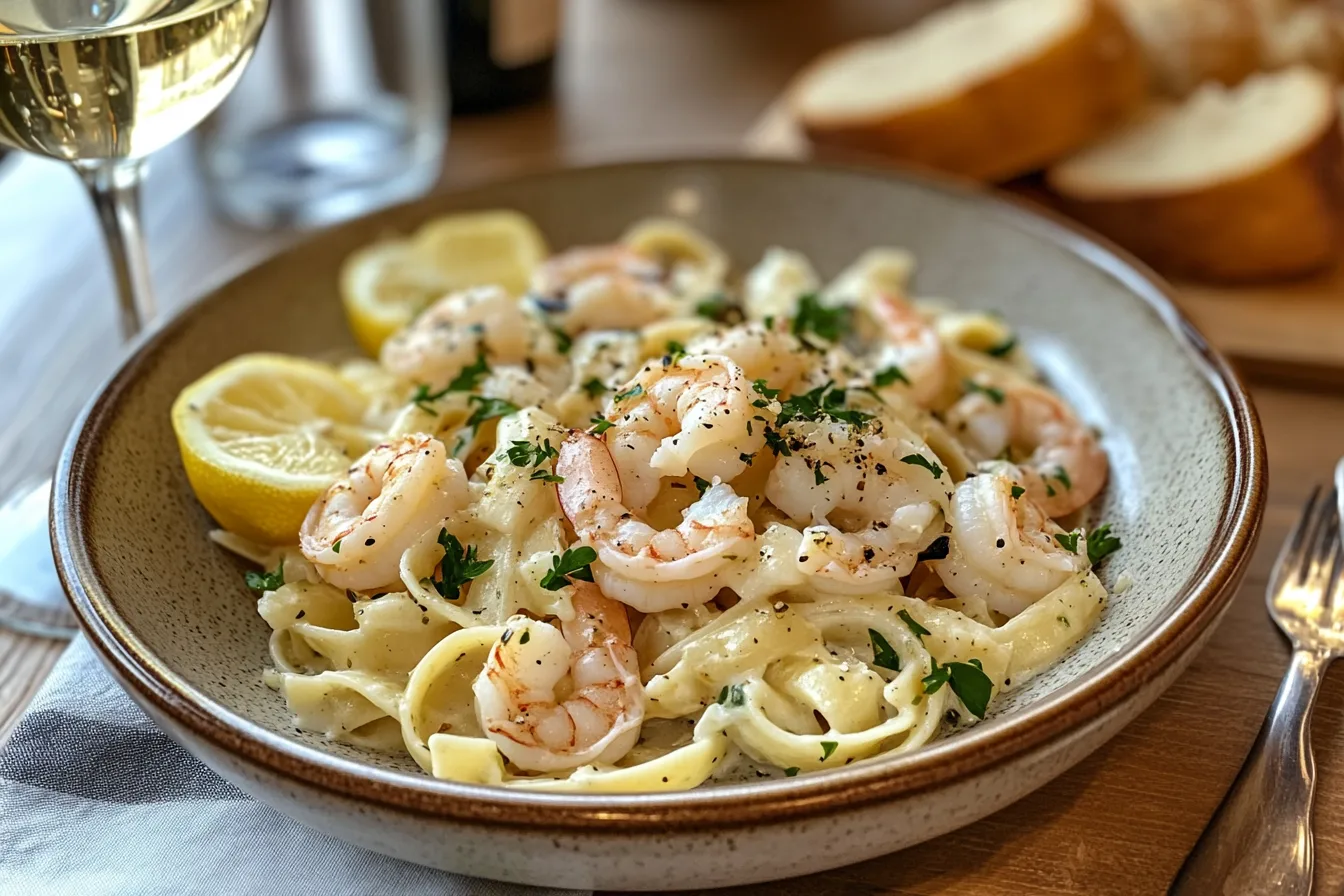Table of Contents
Introduction
Ah, the age-old question: What is the Best Pasta for Your Seafood Dish? Indeed, it’s like trying to pick the perfect dance partner for the ocean’s bounty! This article will dive deep into the world of pasta and seafood pairings, exploring the textures, flavors, and culinary magic that happens when these two ingredients come together. Not only will we uncover the secrets behind choosing the ideal pasta shape for your favorite seafood dishes, but we will also provide tips and techniques to elevate your cooking game. Trust me, you’ll be impressing family and friends in no time!
The marriage of pasta and seafood is a culinary tradition that dates back centuries, particularly in coastal regions of Italy. However, this delightful combination has since spread worldwide, captivating taste buds and inspiring chefs everywhere. Therefore, in this comprehensive guide, we will explore various pasta types, their ideal seafood companions, and the techniques to create mouthwatering dishes that will undoubtedly have you saying “Mamma mia!”
Long and Thin Pasta: The Seafood’s Best Friend
When it comes to seafood pasta, long and thin varieties often steal the show. They’re like the Fred Astaire of the pasta world – elegant, versatile, and always ready to tango with some seafood!
Spaghetti: A Classic Choice
To begin with, spaghetti and seafood? Now that’s a match made in heaven! This long, thin pasta is perfect for a variety of dishes, including:
- Light seafood sauces
- Clam dishes (hello, spaghetti alle vongole!)
- Delicate fish like sole or cod
The thin strands of spaghetti allow the seafood flavors to shine without overpowering them. It’s a classic for a reason, folks! For example, a simple dish of spaghetti tossed with olive oil, garlic, and fresh clams can transport you straight to the Italian coastline. Additionally, spaghetti’s versatility makes it an excellent canvas for a variety of seafood sauces, ranging from light and fragrant to rich and creamy.
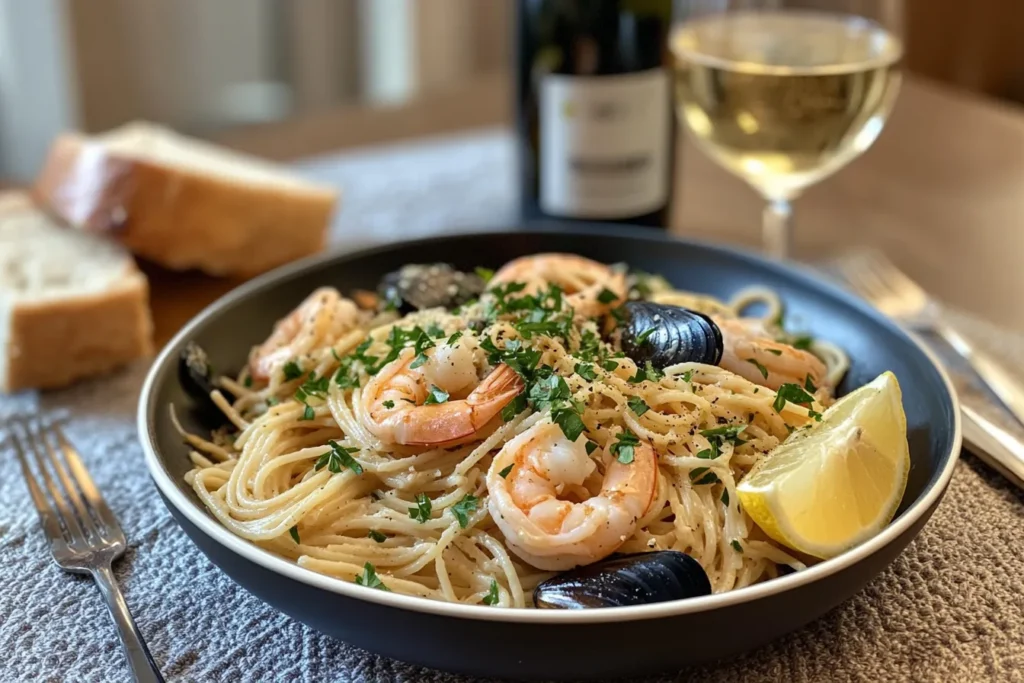
Linguine: The Ribbon-like Wonder
Next up, we have linguine, which, with its flat and wide shape, is like spaghetti’s cooler cousin. It’s ideal for:
- Creamy seafood sauces
- Shellfish dishes (think linguine with mussels)
- Heartier fish like salmon or tuna
The wider surface area of linguine helps it cling to sauces, making each bite a flavor explosion! Furthermore, its slightly thicker texture stands up well to chunkier seafood pieces, creating a harmonious balance in each forkful. Not only that, but linguine also provides a satisfying chew that complements the tender texture of most seafood dishes.
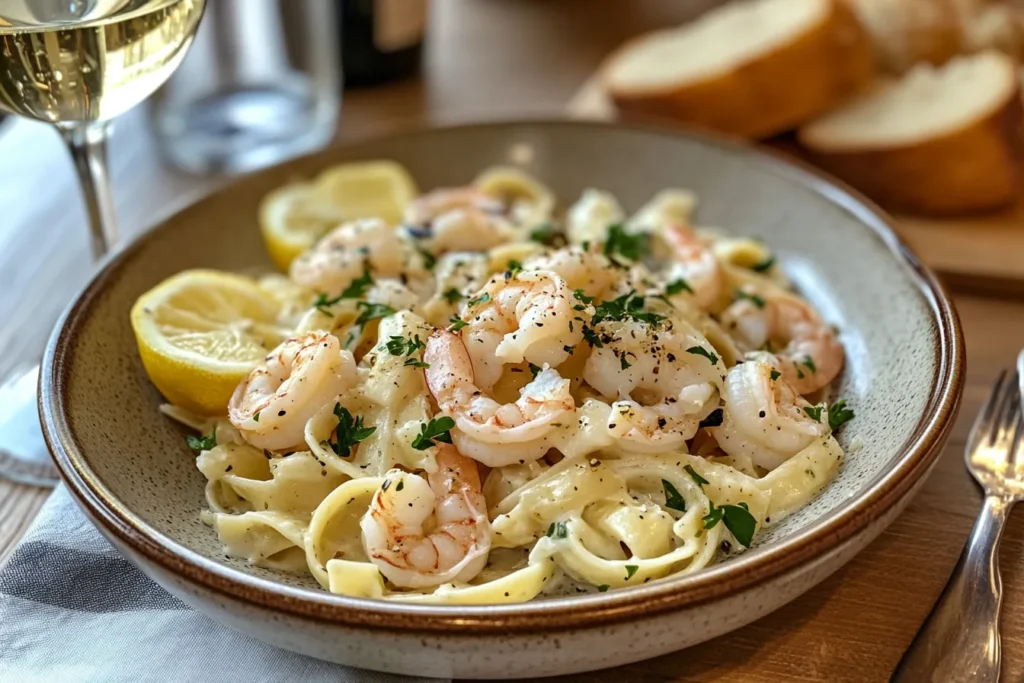
Capellini: The Delicate Angel Hair
Moreover, capellini, also known as angel hair pasta, is the most delicate of the long pasta varieties. It’s perfect for:
- Very light seafood sauces
- Dishes featuring small, tender seafood pieces
- Quick-cooking seafood like scallops or shrimp
Because of its fine texture, capellini cooks incredibly quickly, making it ideal for fast and easy seafood dishes. However, it’s crucial to be careful not to overcook it, as it can quickly become mushy. On the other hand, when prepared correctly, capellini can create an incredibly elegant and refined seafood pasta dish that’s sure to impress your guests.
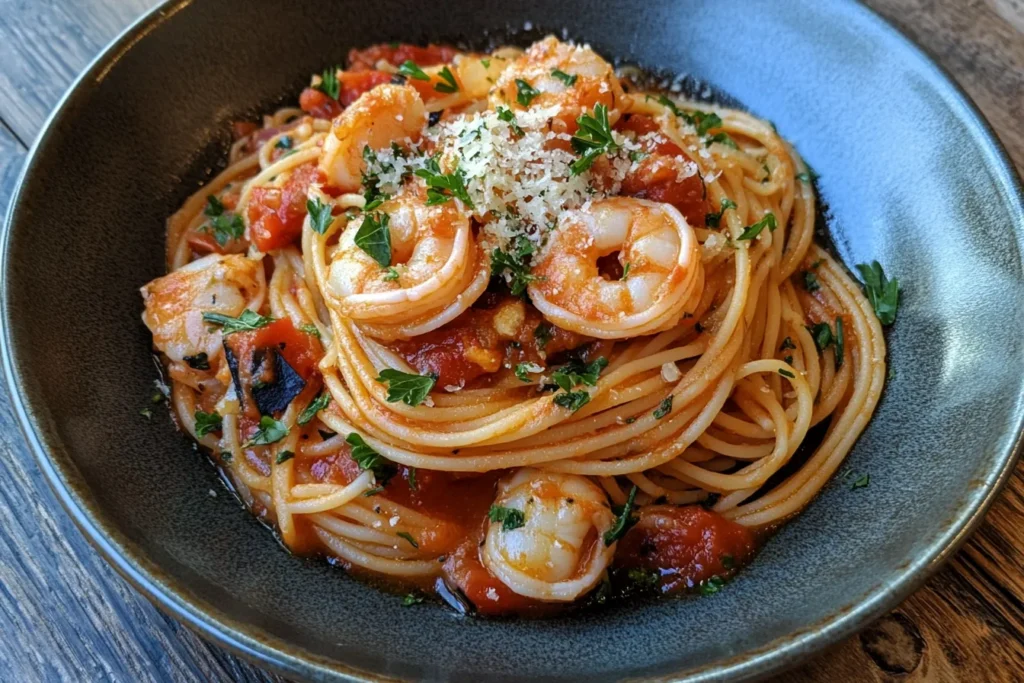
Short Pasta: Ideal for Chunky Seafood Sauces
On the other hand, sometimes you need a pasta that can stand up to chunkier seafood and sauces. This is where short pasta shines – they’re the heavyweight champions of the pasta world!
Penne: The Tubular Delight
First, we have penne, with its tube-like shape and ridged exterior, which is perfect for:
- Seafood pasta bakes
- Chunky tomato-based seafood sauces
- Mixed seafood dishes
The hollow center of penne traps sauce and small pieces of seafood, ensuring that every bite is packed with flavor. Not only that, but its sturdy shape also holds up well in baked dishes, making it a versatile choice for both stovetop and oven preparations. Besides, the ridges on the exterior of penne enhance its ability to cling to sauces, further enriching the overall flavor of the dish.
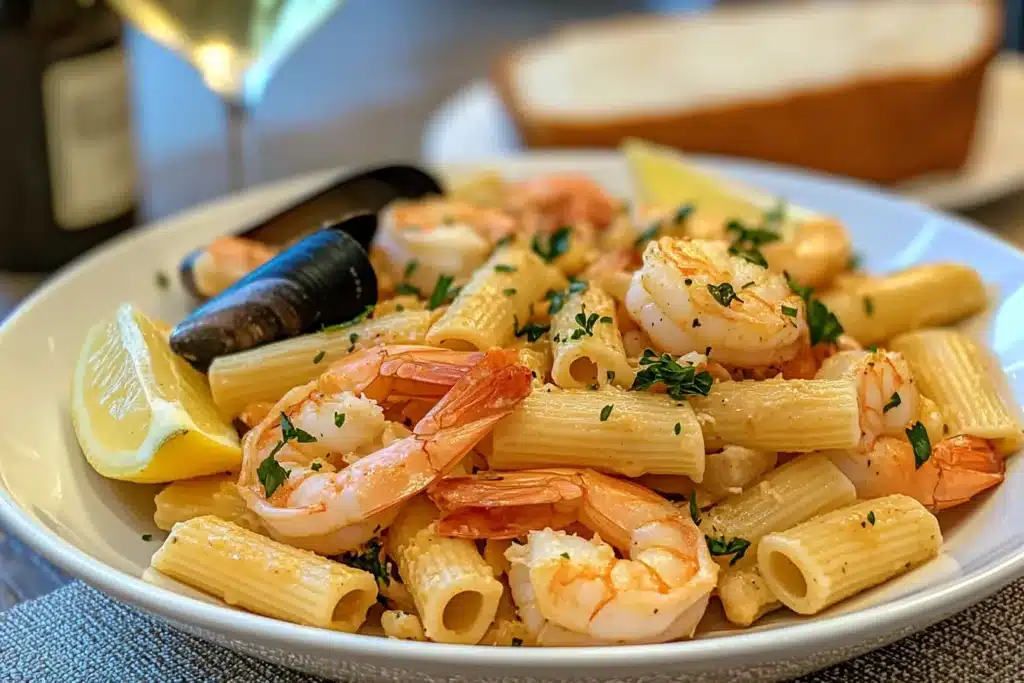
Fusilli: The Spiraled Sensation
In addition to penne, fusilli, with its corkscrew shape, is a fun and functional choice for:
- Seafood pasta salads
- Pesto-based seafood dishes
- Light cream sauces with flaky fish
The spirals of fusilli catch and hold onto sauces and small pieces of seafood, resulting in a tasty and visually appealing option. Furthermore, its playful shape adds an element of whimsy to any seafood pasta dish, making it a hit with both kids and adults alike. In addition, the twists and turns of fusilli create pockets that trap sauce and bits of seafood, ensuring a burst of flavor in every delicious bite.
Farfalle: The Butterfly Beauty
Finally, farfalle, also known as bow-tie pasta, is a charming addition to seafood dishes. It’s great for:
- Cold seafood pasta salads
- Light seafood and vegetable sauces
- Dishes featuring small seafood pieces like shrimp or crab
The unique shape of farfalle not only looks pretty on the plate but also provides varying textures in each bite. The center pinch is slightly thicker, while the “wings” are thinner, creating an interesting mouthfeel that pairs beautifully with seafood. Certainly, its eye-catching shape makes it a popular choice for pasta salads and other dishes where presentation is essential.
Stuffed Pasta: A Seafood Surprise
Who says stuffed pasta can’t join the seafood party? In fact, it’s like a little gift from the pasta gods!
Ravioli: Pockets of Oceanic Flavors
Ravioli stuffed with seafood is a gourmet treat. It’s perfect for:
- Lobster or crab fillings
- Delicate fish mousses
- Ricotta and shrimp combinations
When served with a light butter sauce or a drizzle of olive oil, seafood ravioli can truly be a show-stopper! The delicate pasta pockets protect the seafood filling, allowing for a burst of flavor with every single bite. Certainly, it’s a dish that’s sure to impress at any dinner party. Additionally, the versatility of ravioli allows for endless creativity in seafood fillings, from classic combinations to innovative flavor fusions.
Tortellini: The Ring-shaped Treasure
While not as common as ravioli, seafood-filled tortellini can be a delightful surprise. They’re great for:
- Seafood broths or light soups
- Mixed seafood fillings
- Creamy seafood sauces
The ring shape of tortellini makes them ideal for soaking up flavors in broth-based dishes, while their compact size allows for a variety of seafood fillings in a single serving. Additionally, their shape holds up well in soups, making them an excellent choice for heartier seafood pasta dishes. Moreover, using tortellini can add a touch of sophistication to your seafood pasta repertoire.
Regional Italian Seafood Pasta Specialties
Italy’s diverse coastline has given rise to numerous regional seafood pasta specialties. For instance:
- Spaghetti ai Ricci from Sicily features luxurious sea urchin.
- Trofie al Pesto from Liguria is often served with potatoes and green beans and frequently includes small pieces of fish.
- Spaghetti alle Vongole from Campania is a classic featuring clams, garlic, and sometimes cherry tomatoes.
- Pasta con le Sarde from Sicily combines pasta with sardines, wild fennel, raisins, and pine nuts.
These regional dishes showcase the incredible variety and creativity in Italian seafood pasta cuisine. Above all, they demonstrate how local ingredients and traditions shape culinary practices. Furthermore, exploring these regional specialties can provide a wealth of inspiration for creating your own unique seafood pasta dishes at home.
Cooking Techniques for Perfect Seafood Pasta
To create the perfect seafood pasta dish, consider these essential techniques:
- Cook pasta al dente: Always cook the pasta until it’s firm to the bite because overcooked pasta can ruin the texture of the dish.
- Reserve pasta water: This starchy water can help bind the sauce to the pasta, enhancing the overall flavor.
- Timing is key: Many seafood items cook quickly, so add them to the dish at the right moment to prevent overcooking.
- Use high heat: For dishes like linguine with clams, high heat helps the shellfish open quickly and creates a flavorful sauce.
- Finish cooking in the sauce: Transfer the pasta to the sauce before it’s completely cooked; this allows it to absorb flavors and enhances the overall taste.
By mastering these techniques, you’ll be well on your way to creating restaurant-quality seafood pasta at home. Remember, practice makes perfect, so don’t be discouraged if your first attempts aren’t flawless. Instead, learn from those experiences and keep experimenting!
Sauce Pairings for Seafood Pasta
The sauce can significantly influence your seafood pasta dish. Here are some classic pairings:
- Garlic and olive oil (Aglio e Olio): This is perfect for light seafood like clams or mussels.
- Tomato-based sauces: These are great for mixed seafood dishes or with meatier fish.
- Cream-based sauces: These are particularly delicious with salmon or smoked fish.
- Pesto: This sauce works wonderfully with shrimp or scallops.
- White wine sauce: Ideal for delicate fish and shellfish, adding depth and flavor.
Always remember that the key is to complement, not overpower, the delicate flavors of the seafood. Also, consider the texture of your sauce; for instance, a chunky sauce might work better with a short pasta, while a smooth sauce could pair beautifully with long, thin pasta.
Nutritional Benefits of Pasta and Seafood Combinations
Let’s discuss nutrition, shall we? Pasta and seafood together aren’t just delicious; they’re also packed with nutrients! Check out this table:
| Nutrient | Pasta (1 cup) | Seafood (3 oz) | Benefits |
|---|---|---|---|
| Protein | 8g | 16-20g | Muscle building, satiety |
| Carbs | 43g | 0g | Energy source |
| Omega-3s | 0g | 0.5-1.8g | Heart health, brain function |
| Iron | 1.8mg | 0.5-1.5mg | Oxygen transport |
| Vitamin B12 | 0g | 1.8-5.0mcg | Nerve function, DNA synthesis |
As you can see, combining pasta with seafood creates a well-rounded meal that provides a balance of macronutrients and essential micronutrients. The carbohydrates from pasta serve as an energy source, while the protein from seafood supports muscle health and keeps you feeling full. Moreover, seafood is an excellent source of omega-3 fatty acids, which are crucial for heart and brain health, making this a truly nutritious pairing.
Sustainable Seafood Choices for Pasta Dishes
While we’re on the topic of seafood, it’s also essential to consider sustainability. Overfishing and unsustainable practices have put many fish populations at risk. Therefore, when choosing seafood for your pasta dishes, consider these eco-friendly options:
- Farmed mussels and clams
- Wild-caught Alaskan salmon
- U.S. farmed shrimp
- Pacific sardines
- Farmed Arctic char
- U.S. farmed catfish
By opting for sustainable seafood, you’re not only creating delicious meals but also contributing to the health of our oceans. To summarize, making sustainable choices ensures that we can continue to enjoy seafood pasta dishes for generations to come. Additionally, many sustainable seafood options are rich in nutrients and flavor, making them excellent choices for your culinary creations.
Wine Pairings for Seafood Pasta
No seafood pasta dish is complete without the perfect wine pairing. Here are some suggestions to elevate your dining experience:
- Light, citrusy white wines like Pinot Grigio or Sauvignon Blanc pair beautifully with light seafood pasta dishes.
- For creamy seafood pasta, a buttery Chardonnay complements the richness.
- With tomato-based seafood pasta, a light red like Chianti can work wonderfully.
- Sparkling wines such as Prosecco can provide a delightful contrast to many seafood pasta dishes.
Remember, the best wine pairing is ultimately the one you enjoy most. Thus, don’t be afraid to experiment and find your personal favorite combinations!
Common Mistakes to Avoid in Seafood Pasta Preparation
Even seasoned cooks can sometimes fall into these traps. Here are several common mistakes to avoid:
- Overcooking the seafood: This can result in tough, rubbery textures that ruin your dish.
- Not seasoning the pasta water: Salt in the cooking water is crucial for flavorful pasta.
- Rinsing the pasta after cooking: This removes the starch that helps sauce adhere to the pasta, resulting in a less cohesive dish.
- Using cheese with fish: While there are exceptions, generally, cheese and fish don’t mix well in Italian cuisine.
- Overcrowding the pan: This can lead to steaming rather than searing, affecting the flavor and texture of your seafood.
By avoiding these pitfalls, you’ll be well on your way to creating perfect seafood pasta dishes every time.
Conclusion: The Best Pasta for Your Seafood Dish
So, what’s the verdict on the best Pasta for Your Seafood Dish? Well, it’s not a one-size-fits-all answer! The best Pasta for Your Seafood Dish depends on your seafood, sauce, and personal preference. Here’s a quick cheat sheet to guide you:
- For light, delicate seafood: Opt for long, thin pasta like spaghetti, linguine, or capellini.
- For chunky sauces and mixed seafood: Short pasta like penne, fusilli, or farfalle is your best bet.
- For a gourmet touch: Consider stuffed pasta like seafood ravioli or tortellini.
Remember, the key is to experiment and have fun! After all, in the world of pasta and seafood, there are no wrong answers – just delicious discoveries waiting to be made.
In conclusion, the perfect pasta and seafood pairing is a beautiful dance of textures, flavors, and cooking techniques. Whether you’re craving a light and refreshing linguine with clams or a hearty penne with mixed seafood in a tomato sauce, there’s a pasta out there that’s perfect for your seafood dish.
So go ahead, dive into the world of seafood pasta! Experiment with different pasta shapes, sauces, and seafood combinations. Don’t hesitate to put your own spin on classic dishes or invent entirely new creations. Who knows? You might just discover your new favorite meal!
Finally, remember that cooking is an art, and like any art, it improves with practice. So keep cooking, keep tasting, and keep enjoying the wonderful world of seafood pasta. Buon appetito!

